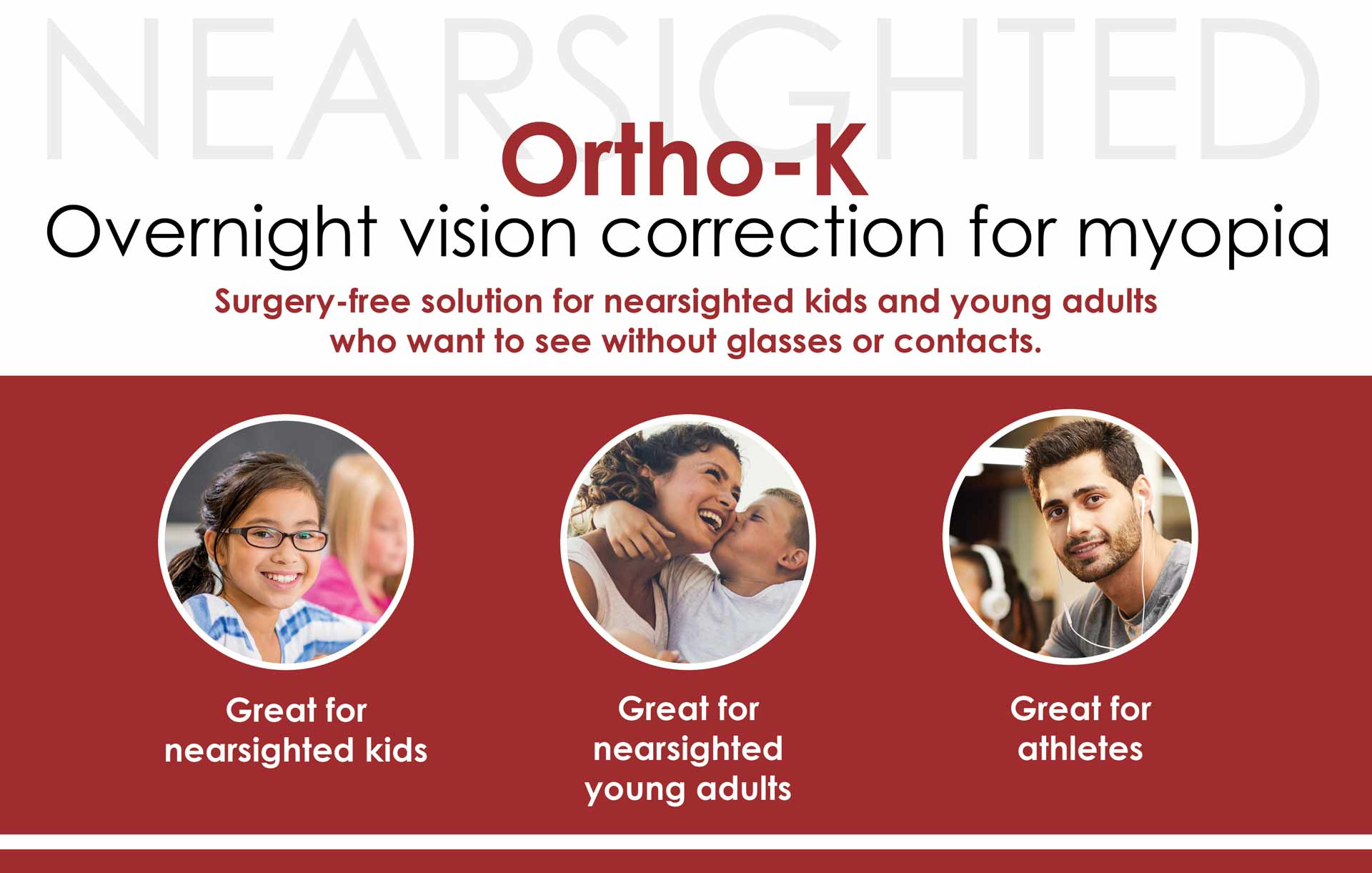Ortho-K

Orthokeratology may sound dramatic, but it is quite simple. 'Ortho' means to correct. Orthodontics correct teeth. Orthopaedics correct the musculoskeletal system. Orthokeratology corrects the refractive error by reshaping the cornea. Orthokeratology, or Ortho-K for short, is a non-surgical and reversible procedure in which custom-designed contact lens devices are used to gently reshape the cornea (front surface) of your eye. It is also known as Corneal Reshaping Technology (CRT) and lenses are worn while sleeping, giving you clear vision during the day without the aid of glasses or contact lenses.
Orthokeratology can correct refractive errors like near-sightedness (myopia), farsightedness (hyperopia), astigmatism and can improve near vision after age 42 (presbyopia).
Ortho-K is ideal for children and adults with the following prescriptions:
- -1.00 up to -8.00 dioptres of myopia
- +1.00 to +4.00 dioptres of hyperopia
- up to moderate (-4.00D) amounts of astigmatism
- Orthokeratology technology continues to evolve, and in many cases, Ortho-K can also successfully correct corneas with high astigmatism, presbyopia and Post-LASIK (refractive surgery) cases with residual refraction errors or irregular treatment areas.
Frequently Asked Questions and Benefits
References
- Morphologic changes in cat epithelium following continuous wear of orthokeratology lenses: a pilot study. 2008 Feb;31(1 ):29-37.
- Chan B, Cho P, de Vecht A. Torie orthokeratology: a case report. Clin Exp Optom. Blackwe ll Publish ing Asia; 2009 Jul:92(4):387-91.
- Gifford P, Swarbrick HA. Time course of corneal topographic changes in the first week of overnight hyperopic orthokeratology. Optom Vis Sci.2008 Dec:85(12):1165-71.
- Gifford P, Swarbrick HA. Refractive changes from hyperopic orthokeratology monovision in presbyopes. Optom Vis Sci. 2013 Apr:90(4):306- 13.
- Chen C, Cho P. Torie orthokeratology for high myopic and astigmatic subjects for myopic control. Clin Exp Optom. 2012 Jan;95(1):103-8.
- Effect of orthokeratology in patients with myopic regression after refractive surgery. 2016 Apr;39(2 ):167-71.
- Recovery of corneal irregular astigmatism, ocular higher-order aberrations, and contrast sensitivity after discontinuation of overnight orthokeratology. 2009 Feb:93(2):203-8.
- Bullimore MA, Sinnott LT, Jones-Jordan LA. The risk of microbial keratitis with overnight corneal reshaping lenses. Optom Vis Sci. 2013 Sep:90(9):937-44.
- Choroidal thickness and axial length changes in myopic children treated with orthokeratology. Contact Lens and Anterior Eye 40 (2017) 417-423.
- Book: Orthokerato logyPrinciples and practice by John Mountford, David Ruston Trusit Dave
- Huang J, Wen D, Wang Q, McAlinden C, Flitcroft I, Chen H, et al. Efficacy Comparison of 16 Interventions for Myopia Control in Children: A Network Meta-analysis. Ophthalmology. 2016 Apr:123(4) :697-708
- Turnbull PRK, Munro OJ, Phillips JR. Contact Lens Methods for Clinical Myopia Control. Optom Vis Sci. 2016 Sep;93(9):1120-6.
- Liu YM, Xie P. The Safety of Orthokeratology--A Systematic Review. Eye Contact Lens. 2016 Jan;42(1 ):35-42.
Reprinted with permission from
https://www.eyespacelenses.com/patient-resources.







